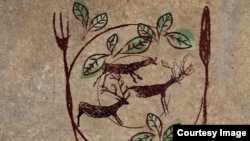New research suggests Neanderthal parents, like their modern-day human counterparts, might have had to lecture their kids to eat their vegetables.
Researchers from MIT and the University of La Laguna in Spain say 50,000-year-old Neanderthal fecal matter suggest our early ancestors were not solely meat-eaters, eating plants, berries, tubers and nuts.
“It’s important to understand all aspects of why humanity has come to dominate the planet the way it does,” said Roger Summons, a professor of geobiology in MIT’s Department of Earth, Atmospheric and Planetary Sciences and co-author of a paper about the discovery in a statement. “A lot of that has to do with improved nutrition over time."
By analyzing samples of the fecal matter, the researchers found “animal-derived cholesterol” but also phytosterol, a compound from plants. This, they say is the “first direct evidence that Neanderthals may have enjoyed an omnivorous diet.”
Summons and his team found the fecal matter at El Salt, a site in Alicante, Spain, where Neanderthals lived. A chemical analysis indicated a “significant plant intake,” researchers said.
According to Ainara Sistiaga, a graduate student at the University of La Laguna,
El Salt has evidence of recurrent Neanderthal occupation dating back tens of thousands of years.
She wrote in an email to VOA that they are sure they are dealing with human fecal matter because of synthesized cholesterol as well as the presence of another byproduct caused by the digestion of plants.
“We use those markers not only to identify the source of the fecal matter but also to deal to the unanswered question of the proportions of each type of food they were actually eaten,” she wrote.
Some previous attempts to discern the Neanderthal diet have been less direct, say the researchers. For example, Neanderthal bone fragments can show that Neanderthals may have eaten “pigs versus cows” but that it would probably underestimate the presence of plants in the diet.
Other studies have looked at vegetable matter stuck in the teeth of Neanderthal remains. This, the researchers say could be a clue that they ate plants, but could also mean they didn’t eat plants directly, but rather by eating the stomach contents of their prey.
In fact, last year, a study saying Neanderthals could have eaten the contents of their prey’s stomachs as an easy source of vegetable matter.
“It could come from the stomach contents, but is unlikely that it is only present in two from five samples [of fecal matter] if it was a regular behavior,” wrote Sistiaga. “In any case, this would represent another way to eat plants.”
The teeth method also could have only proved that Neanderthals perhaps used their teeth as tools, biting plants, but not necessarily eating them.
According to Sistiaga, among primates we are the only dedicated carnivores, and the only ones to take meat from large carcasses.
“Chimpanzees, our closest relatives, show a dependence on ripe fruit, acquiring around 5 percent of its food from meat, and for some, up to 10 percent,” she wrote. adding that chimps can go weeks or months without meat.
Humans, on the other hand, have a relatively large upper gut with bacteria “well suited for lipid digestion.”
Richard Wrangham, a professor of biological anthropology at Harvard University, who was not involved in the study, said in a statement that determining if Neanderthals had eaten plants was “entirely a matter of guesswork” until now.
He added that the new research confirms theories that Neanderthals were not 100 percent carnivores.
“In the end it would not be surprising to find that Neanderthals show little difference from sapiens in their diet composition,” he said in the statement.
The researchers next plan to head to analyze soil sample at Olduvai Gorge in Tanzania, where some of the earliest traces of early man have been found.
The study was published in the journal PLoS ONE.








